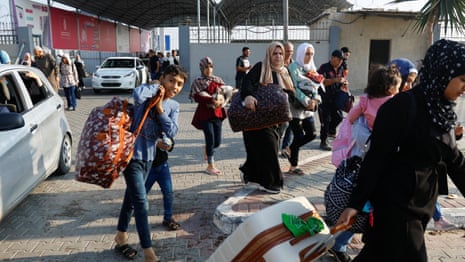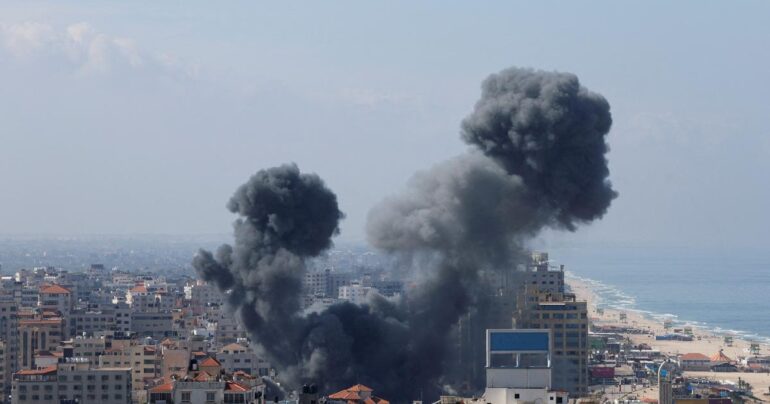Lt Gen Herzi Halevi also says Israeli troops are operating inside city ‘fighting in close quarters’
Israel forces have surrounded Gaza City on three sides and are operating inside the city, fighting in close quarters, their top military commander has said.
In a televised statement, Lt Gen Herzi Halevi, the Israel Defence Forces (IDF) chief of staff, said: “[Israeli forces] are in the heart of northern Gaza, operating in Gaza City, surrounding it.”
Halevi’s comments came as the US secretary of state, Antony Blinken, was heading to Israel and Jordan for talks on Friday to push for the humanitarian pause requested by President Joe Biden.
The intensifying Israeli bombardment has killed thousands of Palestinians, and those sheltering from the assault are running out of clean water and facing increasing health risks as public services become unable to operate and hospitals close.

In Khan Younis, in the south of the densely populated territory, nine-year-old Rafif Abu Ziyada said she was drinking dirty water and getting stomach pains and headaches. “There is no cooking gas, there is no water, we don’t eat well. We are getting sick,” she said. “There’s garbage on the ground and the whole place is polluted.”
Blinken said he planned to discuss concrete steps to minimise harm to civilians in Gaza, adding that in recent days civilians had continued to bear the brunt of the conflict.
Seven United Nations experts called on Thursday for a ceasefire in the territory, saying time was running out for Palestinian people there who were at “grave risk of genocide”. The Israeli mission to the UN in Geneva said it was preparing a response to the experts’ remarks.
Duiring heavy clashes on the outskirts of Gaza’s urban areas in recent days, 18 Israeli soldiers have been killed, including a senior officer, as troops have faced a series of ambushes.
Benjamin Netanyahu said on Thursday that Israeli forces had pushed through the outskirts of Gaza City. “We’re at the height of the battle,” the prime minister said. “We’ve had impressive successes and have passed the outskirts of Gaza City. We are advancing.”
Meanwhile, Israel and Hezbollah continued to exchange fire on Thursday across the Lebanese border, with a rocket fired from Lebanon hitting a house in the northern town of Kiryat Shmona. Hezbollah claimed it had used two drones to target Israeli forces.
Hassan Nasrallah, the secretary general of the Lebanese Shia militant group, is due on Friday to make his first public remarks in Beirut since Hamas’s surprise attack on southern Israel.
In an apparent warning to Hezbollah, with whom the IDF has been engaged in daily cross-border exchanges, Halevi said “less than half” of the Israeli air force was involved in airstrikes on Gaza with “most of its force ready, with bombs loaded should the need arise, to attack on other fronts”.
The White House has called for “humanitarian pauses” to facilitate aid to and evacuations from Gaza but opposed a ceasefire, which it regarded as benefiting Hamas. Blinken’s planned talks were aimed at seeking “urgent mechanisms” to reduce regional tensions, his office said.
Arab countries, including those allied with the US and at peace with Israel, have expressed mounting unease over the war, with Jordan recalling its ambassador to Israel.
The conflict began on 7 October when Hamas launched an onslaught on southern Israel that killed more than 1,400 people and swept up hundreds more as hostages. The current Israeli estimate of the number of hostages is 242. Israeli bombardments have killed at least 8,796 people in Gaza, including 3,648 children, according to the Hamas-run health ministry.
Unicef has described “horrific and appalling” scenes of carnage after two rounds of Israeli airstrikes on the Jabalia refugee camp on Tuesday and Wednesday. “People’s homes have been levelled, hundreds apparently injured and killed, with many children reportedly among the casualties.” The health ministry called the strikes a “heinous massacre” that killed 195 people, including seven hostages.
Israeli officials said the bombing had killed senior Hamas commanders who sought to shield behind civilians and its targeting sought to minimise civilian casualties.
Egypt, meanwhile, said it was preparing to receive “about 7,000” people representing more than 60 nationalities through the newly opened crossing that borders southern Gaza, the foreign ministry said in a statement on Thursday, without specifying a timeline.

A trickle of aid has flowed into Gaza from Rafah since the conflict began but until this week no one was allowed to leave the territory. Foreign governments say there are passport holders from 44 countries, as well as 28 agencies, including UN bodies, in Gaza. The United Arab Emirates said it planned to treat 1,000 children but did not specify how they would travel to the Gulf state.
Germany has said it will ban activities linked to Hamas, already a designated terrorist organisation in the country, as well as those of the pro-Palestinian group Samidoun, which was accused of handing out baked goods in Berlin to celebrate the 7 October attack.
Some Israeli commentators and analysts said that behind the government’s continued rhetoric of vanquishing Hamas and total victory a rethink was taking place, prompted in part by the prospect of mounting IDF casualties and waning international support for Israel amid carnage in Gaza.
“Defeating Hamas has evolved from an immediate tactical objective into a long-term Israeli strategy, one that will include establishing a security zone, mining the border with Gaza and applying ongoing pressure,” Nadav Eyal wrote in Yedioth Ahronoth. “I’m sorry to say, but to me that sounds like another southern Lebanon.”


